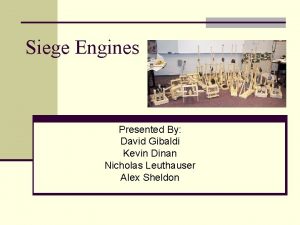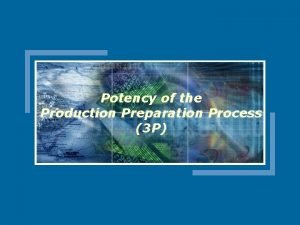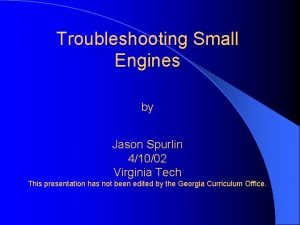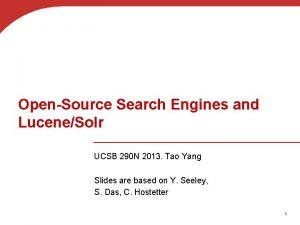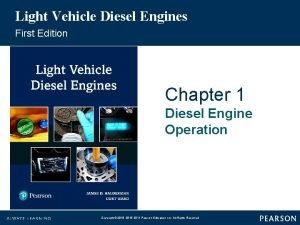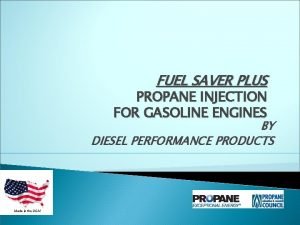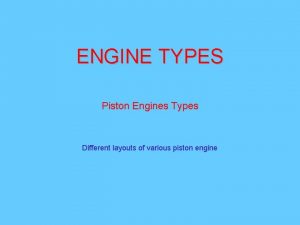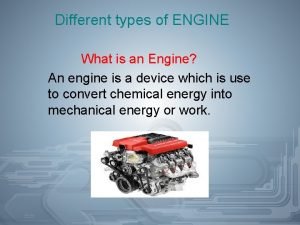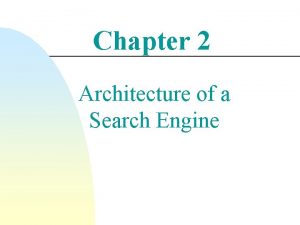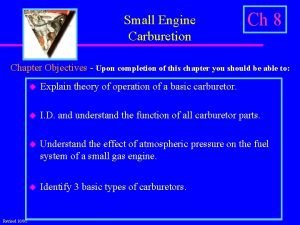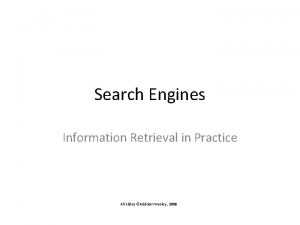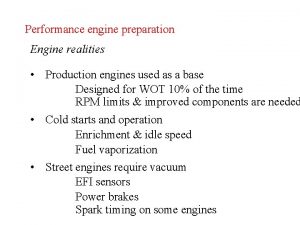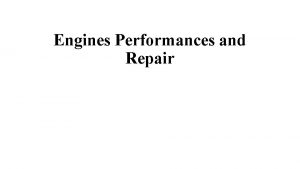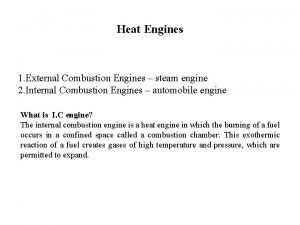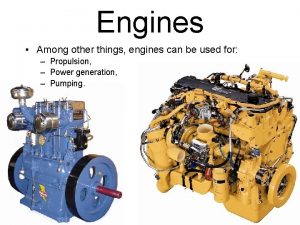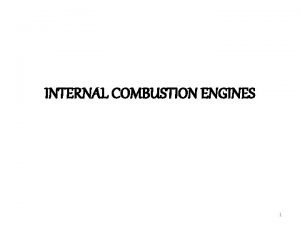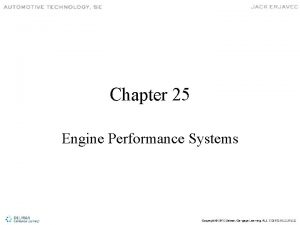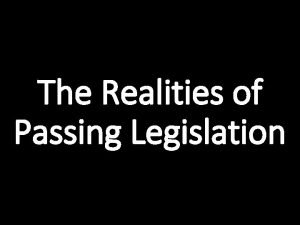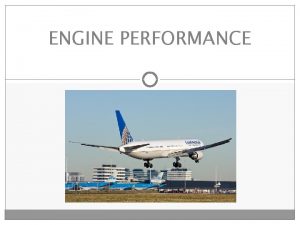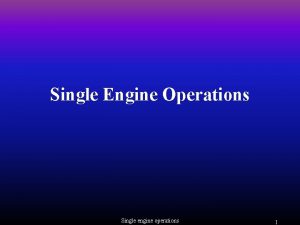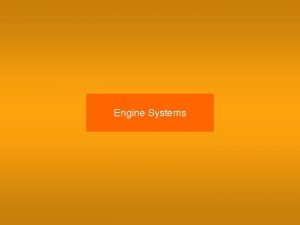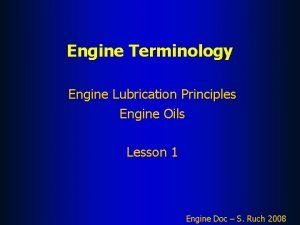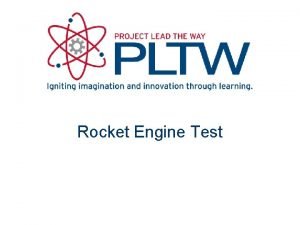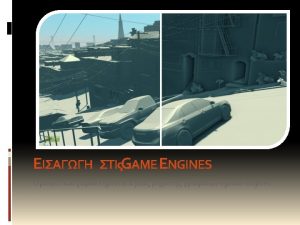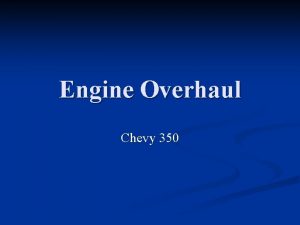Performance engine preparation Engine realities Production engines used
























- Slides: 24

Performance engine preparation Engine realities • Production engines used as a base Designed for WOT 10% of the time RPM limits & improved components are needed • Cold starts and operation Enrichment & idle speed Fuel vaporization • Street engines require vacuum EFI sensors Power brakes Spark timing on some engines

Performance engine preparation Engine realities • Emission testing CO & HC must be controlled NOX tested on a chassis dyno

Performance engine preparation Enhancements for reliability • Increased bearing clearance for cooling Oil volume increases 5 x, with double clearance • High volume oil pumps to maintain pressure • Increased sump capacity & windage trays • Increased spring pressure • Guide plates to stabilize valve trains • Reduced reciprocating weights • High strength fasteners • Engine balance

Performance engine preparation Improving efficiency • Increase cylinder filling on intake stroke Increase volumetric efficiency Increase flow into cylinders • Increase cylinder pressure Mean effective pressure on power stroke Avoid detonation

Performance engine preparation Volumetric efficiency • Air flow into engine divided by swept volume Does not include clearance volume Includes air flow lost during overlap

Performance engine preparation Volumetric efficiency explained • 90% VE means… The volume of piston displacement plus the clearance volume at low pressure after the intake stroke, is equal to 90% of swept volume only at atmospheric pressure.

Performance engine preparation BMEP • Brake Mean Effective Pressure Calculated based on measured torque Max pressure occurs at max VE, near peak torque

Performance engine preparation Formulas • HP @ peak torque = Torque x RPM 5252 • BMEP @ peak torque = HP x 13, 000 Liters x RPM • BMEP @ peak HP = HP x 13, 000 Liters x RPM

Performance engine preparation Effective compression ratio • Calculation based on the volume at IVC • Piston displacement @ IVC + clearance volume Clearance volume • Limited to about 7: 1 with pump gasoline & 100% VE • Can be higher with VE lower than 100%

Performance engine preparation Effective compression ratio (cont. ) • Why high compression pistons? To keep intake valves open longer Maintain the same effective compression ratio Volumetric efficiency improves

Performance engine preparation Effective compression ratio with cam specs • • • Use cam specs to determine IVC point Determine rod ratio = Rod length / stroke length Determine percent of total cylinder volume at IVC Multiply percent by total cylinder volume Calculate effective compression ratio

Performance engine preparation Airflow through ports • Areas of improvement Enlarging valve diameters Porting Increasing lift & duration Reducing restrictions Tuning intake & exhaust runners

Performance engine preparation Flow testing • • Direction of air flow Valves are opened at precise increments Readings are percentages of max flow Percentages are converted to CFM Corrections for temperature, humidity, & pressure Before & after comparisons Flow “under the curve” is most important

Performance engine preparation Improving airflow • Check wall thickness in castings • Improvements without increasing port size Short turn radius Bowl shape

Performance engine preparation Improving airflow • Use gasket to match port • Raise roofline of port • Match other three sides

Performance engine preparation Improving airflow • Enlarge taper below seat to 85% of valve diameter • All seat angles should remain

Performance engine preparation Improving airflow • Reduce restriction around guides Cutting down or rounding • Reduce other restrictions in ports

Performance engine preparation Improving airflow

Performance engine preparation Restrictions at the valves • Valve lift (for 2 valve heads) Estimate for increased output is. . . Valve curtain area equal to valve area • Areas are the same when lift is ¼ of valve diameter • Exhaust lift may not be proportional. Done to get exhaust valve open as far as possible near BDC

Performance engine preparation Restrictions at the valves • Valve lift (for 4 valve heads) Valve area is greater than 2 valve heads Can have less lift & duration • Intake flow begins & peaks earlier

Performance engine preparation Restrictions at the valves • Cautions with oversized valves Piston to valve clearance Shrouding

Performance engine preparation Restrictions at the valves • Oversized intakes should be limited to ½ bore dia • Valve reliefs can be machined Maintain. 200” crown thickness

Performance engine preparation High flow valves • High flow valves have. . . Small radius at fillet Back cut of 20º to 30º Undercut stem

Performance engine preparation High flow valves • Exhaust valves benefit from a smooth radius on upper edge
 Tahapan pre production
Tahapan pre production Siege engine
Siege engine 7 realities of experiencing god diagram
7 realities of experiencing god diagram What forces are defining the new marketing realities?
What forces are defining the new marketing realities? The important realities of human person.
The important realities of human person. International business the new realities
International business the new realities The actual and potential rival offerings
The actual and potential rival offerings 7 realities for experiencing god
7 realities for experiencing god Production preparation process definition
Production preparation process definition Troubleshooting small engines
Troubleshooting small engines Medieval war machines
Medieval war machines Gopher search engine history
Gopher search engine history Knowledge search engines
Knowledge search engines Meta search engine definition
Meta search engine definition Open source search engines
Open source search engines Bill nye fuel injector
Bill nye fuel injector Propane injection
Propane injection Different engine layouts
Different engine layouts What is displacement in cars
What is displacement in cars Edelman engines has 17 billion
Edelman engines has 17 billion Architecture of search engine
Architecture of search engine Other search engines
Other search engines Chapter 8 carburetion answers
Chapter 8 carburetion answers Search engines information retrieval in practice
Search engines information retrieval in practice Nlp search engine
Nlp search engine

